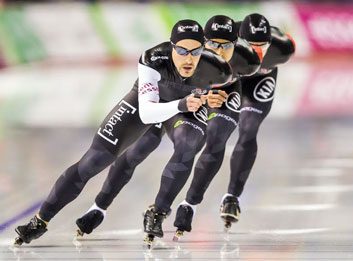
Try a Winter Games sport
Marc R. Rizzardo, a sports physiotherapist and the chief therapist for the Canadian medical team at the Vancouver 2010 and London 2012 Olympic Games, says that although these sports are accessible to people across Canada, anyone with an existing injury should not take them up without first being cleared by a sports physiotherapist or a physician.
Other than that, Rizzardo emphasizes that core strength is key to all the sports we’ll see at the 2014 Olympics. “It is extremely important in specific sports like skeleton and ski jumping, where in other sports like ice hockey and figure skating it is crucial to have a strong core, and then other muscles must complement the core to make the individual specifically strong for that sport,” he says.
Here are 10 sports you’ll see at the Olympics and the kind of workout you can expect to get from each.
Photo by Dave Holland csicalgaryphotos.ca
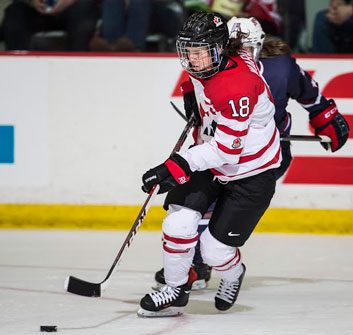
1. Ice Hockey
While we excel at many snow- and ice-based sports, hockey is the big one in Canada. Many of us grow up playing it (either competitively or just on the street with our friends) and, if nothing else, it’s the sport most of us will tune into during the Sochi Winter Games.
Hockey is a great cardio workout but Rizzardo says many hockey players have muscle imbalances. Playing lots of hockey can lead to very strong quadriceps and weak hamstrings, so if you’re involved in this sport or are thinking of taking it up, be sure to hit the gym and work on all your muscle groups so they are balanced.
If you find you have a sore back from playing hockey, try seated rows and back exercises to strengthen your back. Also work on your core and be sure to stretch your hamstrings, gastrocnemius, glutes and low back, says Rizzardo.
Photo courtesy Hockey Canada Images
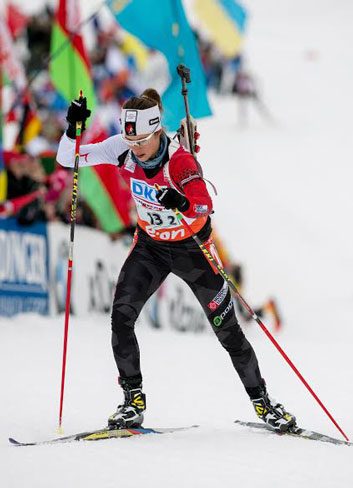
2. Cross-country skiing
Gliding across fresh snow on cross-country skis is a fantastic aerobic workout, says Rizzardo. It also takes more muscle than you may realize: “The poling action of the arms specifically uses the biceps and triceps. The trapezius, latissimus dorsi, pects and rhomboids (muscles between the shoulder blades) all work to support the strenuous work of the arms,” says Rizzardo. In your lower body, if you are using skate-style skis like Olympians, you also need strong hip extensors, hip adductors and hip flexors to get you to the finish line. Phew!
Bonus: Biathlon
Want to amp up your cross-country skiing workout? Combine it with the Summer Olympic sport of Shooting.
According to Rizzardo, competitors in this sport use all the same muscles as those in cross-country skiing, but add the following:
– Crucial strength of the anterior and middle deltoid muscles are needed to hold the rifle steady so that the target can be hit accurately (and the ability to quickly reduce your heart to its resting rate so you can calmly steady the rifle and hit the target is important, too)
– A strong back to carry the rifle. Back extensors need to be addressed during strengthening sessions.
Photo courtesy Biathlon Canada
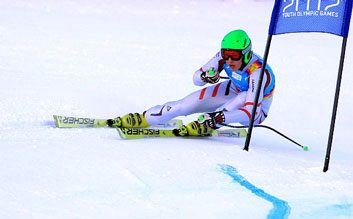
3. Alpine skiing
“To enjoy alpine skiing and minimize the chance of injury, the athlete needs to get his body ready to meet the challenge of the mountain,” says Rizzardo. He recommends skiers focus on these muscles: quadriceps, hip flexors, calves, gluteal, and the upper body, to a lesser extent. “To make sure that muscle imbalances are not created, working out the hamstrings is a good idea, too,” says Rizzardo.
Balance and proprioception (the ability to know where the body is in space without necessarily looking) are also key for downhill skiing. When you’re traveling downhill at over 160 km per hour, you need to have a good grasp of where you are and what’s around you! Try improving your balance and stability by standing on a BOSU ball using light dumbbells.
Photo: Keystone Press
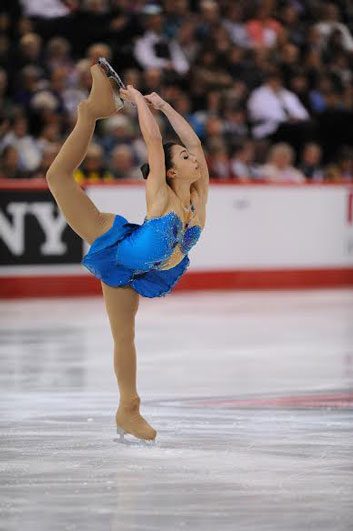
4. Figure skating
Canada has a rich history of spectacular figure skaters, going back to Barbara Anne Scott and through many years to Brian Orser, Elvis Stojko, Jamie Sale and David Pelletier and our current world leader and Sochi gold medal hopeful Patrick Chan.
Rizzardo describes the sport has having “evolved from a gracious, elegant event requiring fantastic artistic interpretation to one that also requires some raw power.” Just think about those quad jumps (four full revolutions in the air!) – those require some extremely strong quadriceps and hamstrings. Skaters all need “phenomenal flexibility,” says Rizzardo. Activities like yoga, Pilates or ballet are important parts of a serious skater’s routine.
To build strength for figure skating, try plyometrics and tons of lunges. Upper body strength is also of the utmost importance, especially for male partner figure skaters who do a lot of lifting with their partner.
“Balance, flexibility, proprioception and agility are key components that also need to be worked on in the gym,” says Rizzardo. Figure skating is a true full-body workout!
Photo of Gabrielle Dalemen ©Skate Canada/Stephan Potopnyk

5. Speed skating
“The cardiovascular output is phenomenal in these athletes,” says Rizzardo. They may be sprinting distances as short as 500 metres or as long as 10,000 metres.
Keep in mind that speed skates are different from figure or hockey skates. They will take some getting used to if you’re just strapping them on for the first time!
According to Rizzardo, speed skaters depend on lower body strength (quadriceps, hamstrings, hip flexors, gastrocnemius); great proprioception; ankle flexibility, stability, and strength; and mental toughness. Core strength is a must for this sport. Just think: coming into tight turns very close to your competitors, your body is almost horizontal. Your core is what will keep your body aligned and your muscles firing properly.
“Many times the athletes need to train away from the rink,” says Rizzardo. “Cycling is a good substitute and many of the world’s top speed skaters compete in cycling as well.” (Clara Hughes is a six-time Olympic medallist in cycling and speed skating, winning multiple medals in both the Summer and Winter Games.)
Photo: Denny Morrison front, Lucas Makowsky middle and Mathieu Giroux, rear in the men’s team pursuit. Taken by Dave Holland csicalgaryphotos.ca
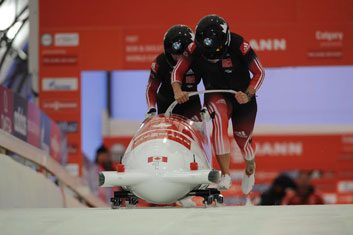
6. Bobsled
“This sport may represent the most comprehensive strength attributes of any of the Winter Olympic sports,” says Rizzardo. Bobsledders generate a huge amount of power and speed right off the start. “Many top sprinters become bobsledders because of their powerful legs,” says Rizzardo. They’re using their quadriceps, hamstrings, gastrocnemius, glutes and hip flexors to get the sled off the start line as quickly as possible before jumping in.
Then everything shifts: once they’re in the sled, says Rizzardo, athletes need to stay calm and use their core muscles to help stabilize the sled while the driver anticipates the corners and keeps the sled on track.
Photo by Charlie Booker
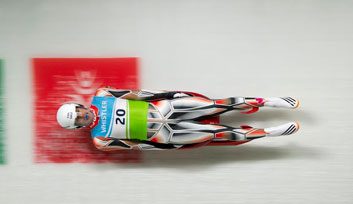
7. Luge and skeleton
These two sports employ similar muscles (and are equally as scary, if you ask us!)
Whether they’re face-first or feet-first, skeleton competitors and lugers need to remain as still as possible while simultaneously moving the sled ever so slightly to get into and out of corners safely. “It goes without saying that core strength is vital for these events,” says Rizzardo. “Very strong back and abdominal musculature is critical for the athlete to compete safely and successfully.”
Skeleton has the added skill set of being able to race with your face inches from the ice, says Rizzardo. “Can you say mentally tough?”
Photo by David McColm
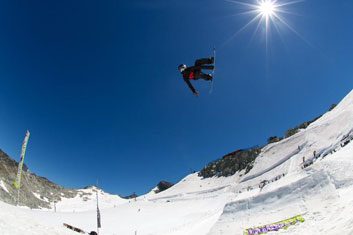
8. Snowboarding
Yes, competitive snowboarding tends to be dominated by younger athletes who can contort their bodies into crazy positions. But that doesn’t mean you can’t take it up on your local slope for a great workout.
Rizzardo says strong lower body muscles are critical for snowboarding, especially for jumps. Flexibility and a strong core will help – use a BOSU ball to work on both. Start with downhill workouts and then build your way up to something like the half pipe when you feel comfortable.
Photo courtesy Canada Snowboard
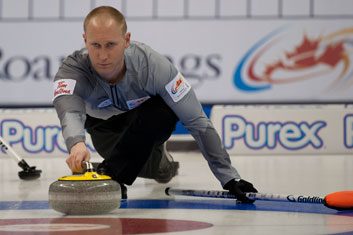
9. Curling
Think curling doesn’t take much athletic ability or strength? Think again. “The flexibility required at the hip and shoulder is remarkable,” says Rizzardo. “Throwing the rock requires tremendous flexibility. At times the body is almost horizontal to the ice surface when the rock is released.”
Shoulder strength and stability is key for throwing curling rocks and having them land where you want them to (but sometimes a delicate touch is all that’s required). When you’re sweeping, you’re using your shoulders again as well as back strength, says Rizzardo. To strengthen these areas, focus on your mid-thoracic area by doing seated rows and retraction exercises.
Many curlers experience knee problems. If you experience this, see a sports health practitioner for suggestions on exercises to help you develop good muscle memory.
Photo: Team Canada skip Brad Jacobs. Photo courtesy Canadian Curling Association/Michael Burns
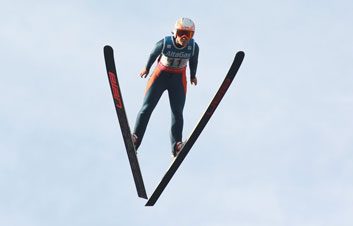
10. Ski jumping
“Have you ever stood at the top of the Olympic ski jump? Well, I have and it’s terrifying!” laughs Rizzardo, recounting Eddie the Eagle from Great Britain during the 1988 Calgary Olympics, who “would sit at the end of the bench waiting his turn, and when it came up he would retreat to the end of the bench trying to go last with each rotation!” He was there to compete for an Olympic medal, but was legitimately afraid to jump. “So, besides using a good strengthening program that includes some very good core exercises, mental toughness is absolutely critical in this sport.”
Rizzardo says a strong core is not only critical for ski jumping, but also “absolutely mandatory.” Athletes also need to be able to flex their ankles in a way that their feet come as close very close to their shins so their upper bodies can be held out in front on the jump to get as much distance as possible.
“Back extensors, gluts, hamstrings and quads all work together to keep the body as still as possible during the event. Strong quads are very important on the landing as the quads need to work eccentrically to absorb the shock of landing from such a high distance,” says Rizzardo. Develop these important muscles through plyometrics and lunges.
Photo of 2014 Canadian Olympic Team nominee Atsuko Tanaka. Photo by Mike Ridewood, Canadian Olympic Committee.
Related:
• Sochi 2014: New Olympic events
• Sochi 2014: Canadians to watch
• Healthy Russian foods
